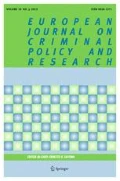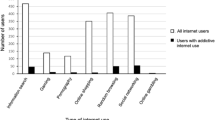Abstract
The use of the Internet and new technologies now seems to permeate the entire society, affecting every aspect of daily life. Although this change is characterized by undeniable positive aspects, it simultaneously bears a number of risks which are higher especially with respect to the growing number of younger users. In fact, young people, as the most involved in cyber space, are an age group most exposed to the dangers of improper and not aware use of electronic tools. The specific aim of this research was to study unwanted online attentions (UOA) among a sample of Italian students (N = 585, mean age = 14.5), identifying UOA as all those behaviors carried out through the Internet and technology to annoy, disturb, offend, humiliate, intimidate, threat, harass, harm or attack others. The online questionnaire investigated the online habits of the students, the presence of UOA and the characteristics of victims and perpetrators, the perception and emotional impact of such conducts, and the victims' possible reactions. The findings offer an estimate of the prevalence of these behaviors in the population of this age group in the area considered. More importantly, the results reveal a very high involvement in technology by the students accompanied by a lack of awareness regarding the risks connected to technology use as well as a low perception of UOA. These results give evidence of the needs in terms of prevention and education instruments in order to improve the system of responses to cybervictimization among young people.
Similar content being viewed by others
References
Agatson, P., Kowalski, R., & Limber, S. (2007). Students’ perspective on cyber bullying. Journal of Adolescent Health, 41, S59–S60.
Alvarez, A. R. (2012). “IH8U”: confronting cyberbullying and exploring the use of cyber tools in teen dating relationships. Journal of Clinical Psychology, 68(11), 1205–1215.
Boyd, D. (2008). Why youth heart social network sites: The role of the networked publics in teenager social life. In D. Buckingham (Ed.), Youth, identity, and digital media (pp. 119–142). Cambridge: MIT Press.
Brighi, A., Guarini, A., Tomassoni, S., & Genta, M. L. (2013). La ricerca ECIP: Nuove tecnologie, cyberbullismo e ruolo della famiglia. In M. L. Genta, A. Brighi, & A. Guarini (Eds.), Cyberbullysmo. Ricerche e strategie di intervento (pp. 62–74). Milano: Franco Angeli.
Brolin Laftman, S., Modin, B., & Ostberg, V. (2013). Cyberbullying and subjective health. A large-scale study of students in Stockholm, Sweden. Children and Youth Services Review, 35, 112–119.
Buccoliero, E., & Tirotta, R. (2013). Adolescenti e media: il progetto “La rete siamo noi”. In M. L. Genta, A. Brighi, & A. Guarini (Eds.), Cyberbullysmo. Ricerche e strategie di intervento (pp. 75–87). Milano: Franco Angeli.
Calvete, E., Orue, I., Estévez, A., Villardón, L., & Padilla, P. (2010). Cyberbullying in adolescents: modalities and aggressors’ profile. Computers in Human Behavior, 26, 1128–1135.
Chisholm, J. F. (2006). Cyber space violence against girls and adolescent females. Annals New York Academy of Sciences, 1087, 74–89.
Connolly, J., Hussey, P., & Connolly, R. (2014). Technology-enabled bullying and adolescent resistance to report. The need to examine casual factors. Interactive Technology and Smart Education, 11(2), 86–98.
Davison, C. B., & Stein, C. H. (2014). The dangers of cyberbullying. North American Journal of Psychology, 16(3), 595–606.
De Fazio, L., & Sgarbi, C. (2012). Nuove prospettive di ricerca in materia di atti persecutori: il fenomeno del cyberstalking. Rassegna Italiana di Criminologia, 4(3), 146–159.
Dehue, F., Bolman, C., & Völlink, T. (2008). Cyberbullying: youngsters’ experiences and parental perception. Cyber Psychology & Behavior, 11(2), 217–223.
Dempsey, A. G., Sulkowski, M. L., Dempsey, J., & Storch, E. A. (2011). Has cyber technology produced a new group of peer aggressors? Cyberpsychology, Behavior and Social Networking, 14(5), 297–302.
Eurispes – Telefono Azzurro (2011). Indagine conoscitiva sulla condizione dell’infanzia e dell’adolescenza in Italia 2011. Documento di Sintesi. Resource document, sin tesi-indagine-conoscitiva-sulla-condizione-dellinfanzia-e-delladolescenza-in-italia- 2011&catid=40:comunicati-stampa&Itemid=135. Accessed March 2015.
Farber, B A., Shafron, G., Hamadani, J., Wald, E., & Nitzburg, G. (2012). Children, technology, problems, and preferences. Journal of Clinical Psychology: in Session 1–5.
Griezel, L., Finger, L., Bodkin-Andrews, G. H., Craven, R. G., & Yeung, A. S. (2012). Uncovering the structure of and gender and developmental differences in cyber bullying. The Journal of Educational Research, 105(6), 442–455.
Hinduja, S., & Patchin, J. W. (2008). Cyberbullying: an exploratory analysis of factors related to offending and victimization. Deviant Behavior, 29, 129–156.
Hinduja, S., & Patchin, J. W. (2009). Bullying beyond the schoolyard: Preventing and responding to cyberbullying. Thousand Oaks: Sage.
Hinduja, S., & Patchin, J. W. (2010). Bullying, cyberbullying and suicide. Archives of Suicide Research, 14, 206–221.
Kowalski, R. M., & Limber, S. P. (2007). Electronic bullying among middle school students. Journal of Adolescent Health, 41(6, Supplement 1), S22–S30.
Kowalski, R. M., Giumetti, G. W., Schroeder, A. N., & Lattanner, M. R. (2014). Bullying in the digital age: a critical review and meta-analysis of cyberbullying research among youth. Psychological Bulletin, 140(4), 1073–1137.
Lau, W. W. F., & Yuen, A. H. K. (2013). Adolescents’ risky online behaviours: the influence of gender, religion, and parenting style. Computers in Human Behavior, 29, 2690–2696.
Lembrecht, L. (2012). Digital image bullying among school students in Belgium: an exploration of the characteristics of bullies and their victims. International Journal of Cyber Criminology, 6(2), 968–983.
Lenhart, A., Purcell, K., Smith, A., & Zickuhr, K. (2010). Social media and young adults. Pew Research Center – Internet, Science and Tech. Resource document. http://www.pewinternet.org/2010/02/03/social-media-and-young-adults/. Accessed February 2015.
Li, Q. (2007). New bottle but old wine: a research of cyberbullying in schools. Computers in Human Behavior, 23(4), 1777–1791.
Marcum, C. D., Higgins, G. E., & Ricketts, M. L. (2011). Potential factors of online victimization of youth: an examination of adolescent online behaviors utilizing routine activities theory. Deviant Behavior, 31(5), 1–31.
Marcum, C. D., Higgins, G. E., & Ricketts, M. L. (2014a). Juveniles and cyber stalking in the United States: an analysis of theoretical predictors of patterns of online perpetration. International Journal of Cyber Criminology, 8(1), 47–56.
Marcum, C. D., Higgins, G. E., Freiburger, T. L., & Ricketts, M. L. (2014b). Battle of the sexes: an examination of male and female cyber bullying. International Journal of Cyber Criminology, 6(1), 904–911.
Menesini, E., Nocentini, A., Palladino, B. E., Frisén, A., Berne, S., et al. (2012). Cyberbullying definition among adolescents: a comparison across six European countries. Cyberpsychology, Behavior and Social Networking, 15(9), 455–463.
Mishna, F., Cook, C., Gadalla, T., Daciuk, J., & Solomon, S. (2010). Cyber bullying behaviors among middle and high school students. The American Journal of Orthopsychiatry, 80(3), 362–374.
Mishna, F., Khoury-Kassabri, M., Gadalla, T., & Daciuk, J. (2012). Risk factors for involvement in cyber-bullying: victims, bullies and bully-victims. Children and Youth Services Review, 34, 63–70.
Mitchell, K. J., & Ybarra, M. L. (2007). Online behavior of youth who engage in self-harm provides clues for preventive intervention. Preventive Medicine, 45(5), 392–396.
Mitchell, K. J., Ybarra, M. L., & Finkelhor, D. (2007). The relative importance of online victimization in understanding depression, delinquency, and substance use. Child Maltreatment, 12(4), 314–324.
Mitchell, K. J., Finkelhor, D., Wolak, J., Ybarra, M. L., & Turner, H. (2011). Youth internet victimization in a broader victimization context. Journal of Adolescent Health, 48, 128–134.
Perren, S., Dooley, J., Shaw, T., & Cross, D. (2010). Bullying in school and cyberspace: associations with depressive symptoms in Swiss and Australian adolescents. Child and Adolescent Psychiatry and Mental Health, 4, 28. doi:10.1186/1753-2000-4-28.
Phillips, M., & Spitzberg, B. H. (2010). Speculating about spying on myspace and beyond: Social network surveillance and obsessive relational intrusion. In K. B. Wright & L. M. Webb (Eds.), Computer-mediated communication in personal relationships (pp. 344–367). NY: Peter Lang.
Sgarbi, C., & De Fazio, L. (2014). Lo stalking: profili vittimologici e strumenti di tutela delle vittime. Rassegna Italiana di Criminologia, 1(8), 50–60.
Shariff, S. (2009). Confronting cyber-bullying: What schools need to know to control miscounduct and avoid legal consequences. New York: Cambridge University Press.
Slonje, R., & Smith, P. K. (2008). Cyberbullying: another main type of bullying? Scandinavian Journal of Psychology, 49(2), 147–154.
Smith, P., Mahdavi, J., Carvalho, M., Fisher, S., Russell, S., & Tippett, N. (2008). Cyberbullying: its nature and impact in secondary school pupils. Journal of Child Psychology and Psychiatry, 49(4), 376–385.
Smith, P. K., Thompson, F., & Davidson, J. (2014). Cyber safety for adolescent girls: bullying, harassment, sexting, pornography, and solicitation. Current Opinion in Obstetrics & Gynecology, 26(5), 360–365.
Spitzberg, B. H., & Cupach, W. R. (2007). Cyberstalking as (Mis)matching. In M. T. Whitty, A. J. Baker, & J. A. Inman (Eds.), Online matchmaking (pp. 127–146). UK: Palgrave Macmillan.
Spitzberg, B. H., & Cupach, W. R. (2014). The dark side of relationship pursuit: From attraction to obsession and stalking (2nd edn.). New York: Routledge.
Spitzberg, B. H., & Hoobler, G. (2002). Cyberstalking and the technologies of interpersonal terrorism. New Media & Society, 14, 67–88.
Tokunaga, R. S. (2010). Following you home from school: a critical review and synthesis of research on cyberbullying victimization. Computers in Human Behavior, 26(3), 277–287.
Vandebosch, H., & Van Cleemput, K. (2008). Defining cyberbullying: a qualitative research into the perceptions of youngsters. Cyber Psychology & Behavior, 11(4), 499–503.
Varjas, K., Talley, J., Meyers, J., Parris, L., & Cutts, H. (2010). High school students’ perceptions of motivations for cyberbullying: an exploratory study. Western Journal of Emergency Medicine, 11(3), 269–273.
Wolak, J., Mitchell, K., & Finkelhor, D. (2006). Online victimization: 5 years later. Alexandria: National Center for Missing & Exploited Children.
Wolak, J., Mitchell, K. J., & Finkelhor, D. (2007). Does online harassment constitute bullying? An exploration of online harassment by known peers and online-only contacts. Journal of Adolescent Health, 41, S51–S58.
Ybarra, M. L., & Mitchell, K. J. (2004). Online aggressor/targets, aggressors, and targets: a comparison of associated youth characteristics. Journal of Child Psychology and Psychiatry, 45(7), 1308–1316.
Ybarra, M. L., & Mitchell, K. J. (2007). Prevalence & frequency of Internet harassment instigation: implications for adolescent health. Journal of Adolescent Health, 41(2), 189–195.
Ybarra, M. L., Mitchell, K. J., Wolak, J., & Finkelhor, D. (2006). Examining characteristics and associated distress related to internet harassment: findings from the second youth internet safety survey. Pediatrics, 118, 1169–1177.
Ybarra, M. L., Mitchell, K. J., Finkelhor, D., & Wolak, J. (2007). Internet prevention messages. Targeting the right online behaviours. Archives of Pediatrics & Adolescent Medicine, 161, 138–145.
Acknowledgments
The study was supported by a grant from a Local Bank Foundation (FCRMO). The authors acknowledge all the researchers who participated to the survey, Engineering Department of the University of Modena and Reggio Emilia for the development of the electronic version of the questionnaire, Cinzia Del Giovane for her assistance with statistic analysis, and Amanda Krause for stylistic and language revision.
Author information
Authors and Affiliations
Corresponding author
Rights and permissions
About this article
Cite this article
De Fazio, L., Sgarbi, C. Unwanted Online Attentions Among an Italian Students Sample. Eur J Crim Policy Res 22, 219–234 (2016). https://doi.org/10.1007/s10610-015-9296-4
Published:
Issue Date:
DOI: https://doi.org/10.1007/s10610-015-9296-4




